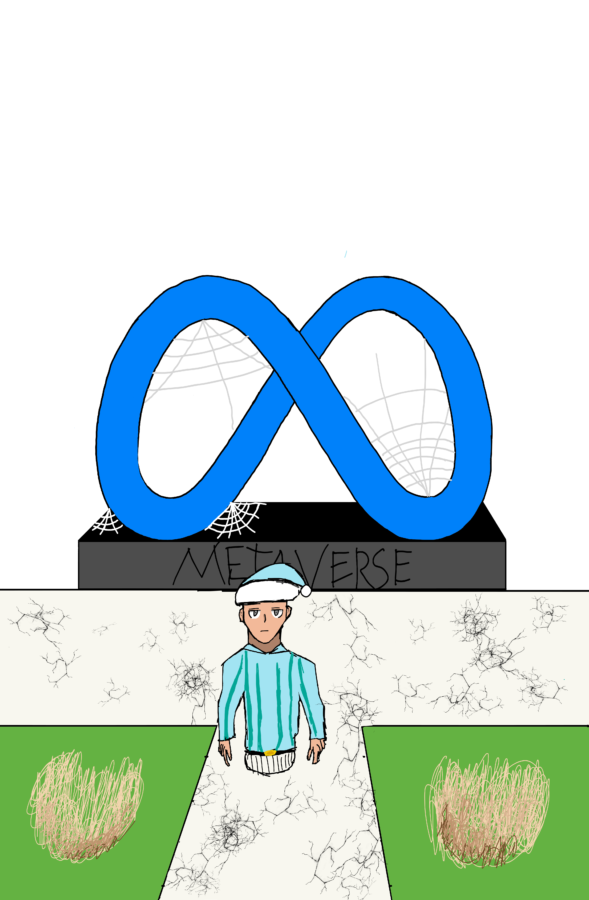The Metaverse is a billion dollar disaster
Imagine a virtual world where you don’t need a large monitor or even a computer. You just put on a headset and are instantly transported to anywhere in the world where you can work with your colleagues.
That’s the future that Mark Zuckerberg envisioned when he rebranded Facebook as Meta and dedicated his company to developing the Metaverse. Zuckerberg expressed his belief that the Metaverse was the future of the Internet. Is it really the future though? Let’s take a step back and see where the Metaverse came from and whether it can be saved.
The Metaverse, first coined in 1992 by author Neal Stephenson in the book “Snow Crash,” has been at the forefront of many people’s minds lately. Companies like Meta (formerly known as Facebook) spent over $36 billion on The Metaverse. Zuckerberg’s reasoning? The Metaverse is the future of computing. Yeah, I don’t think so. Since 2019, Meta’s VR division, Reality Labs, has lost over 30 billion That money could’ve been used to make Facebook and Instagram appealing to younger generations, take care of it’s employees, and fix it’s reputation as a company.
Even with all the money being used, the Metaverse, right now, is dumb. As a side note, there are two major terms that I’ll be using that need to be explained. Virtual reality (VR) is complete immersion in a virtual world. Augmented Reality (AR) is virtual elements on top of the existing world like what we see in Snapchat filters.
Four months after Facebook renamed itself to Meta, Disney announced that they were creating a next-generation storytelling and consumer experiences division. It was a 50-person team that was supposed to research how Disney could enter the fledgling metaverse. Former CEO Bob Chapek called it “the next great storytelling frontier.”
That was until former CEO Bob Iger stepped back into his role and announced 7,000 employees would be laid off. He decided to eliminate the entire metaverse division in order to save money. However, it’s not just Disney that is shifting focus away from the Metaverse. Microsoft is no longer focusing on the Metaverse, Walmart shut down its “Universe of Play” world on Roblox, and even Meta is laying off more people after its first round of layoffs.
The Metaverse has always been around — just not the way you think. Roblox, Minecraft, and Horizon Worlds are all versions of the metaverse. The first two were more successful than Horizon by a long shot. Many companies believed that the Metaverse is the future of the internet, so much so that even Facebook renamed itself Meta.
These companies promote the Metaverse like it’s the future. However, the truth is, it’s not the future. Remember 3D TVs? Companies said that those TVs were the future. We don’t see those anymore, because they weren’t very good. The Metaverse will probably die the same death as 3D TVs. A slow decline into nothing.
I’ve been pretty harsh on the Metaverse, but it has some hope to live. Meta has some cool ideas, but they just need a lot of work. However, I have some issues with Meta’s version of the Metaverse, the biggest one being the idea that Meta owns the entire Metaverse. Meta doesn’t have the best track record in regard to data collection. So, I have a problem with Meta tracking my eyes and my facial movements. Also, there’s not enough regulation to protect how our biometric data is used by these companies.
Meta’s version of the metaverse, specifically Horizon Worlds, is also not very good. In February 2022, Meta bragged that Horizon had 300,000 users and 200,000 monthly users. They believed that they could hit 500,000 monthly users by the end of the year. Meta adjusted its expectations and hoped to hit 280,000 monthly users. However, Horizon Worlds will never be popular if it continues to be a buggy mess. Even Meta employees aren’t using Horizon Worlds — that’s how bad it is. If Mark Zuckerberg wants this to be the future, he has to stop adding new features and make Horizon a stable app that people want to be in.
Horizon Worlds had reports of women being sexually harassed, and Meta responded by adding a personal boundary feature. This feature should’ve been built into the app already. Why did it take so long — and in terrible situations like this — for Meta to protect women online?
Meta also needs to set its priorities straight. For example, Meta wants to add legs to avatars. That’s fine and all, but Horizon is a buggy mess. No one wants to spend more than an hour in Horizon because it’s a hassle to deal with. Meta should protect its users online and make Horizon better before adding in fun features.
Another VR app called Decentraland held its second annual Metaverse Fashion Week on March 28-31. It had all the big-name fashion brands such as Coach, Adidas, Balenciaga. However, the fashion week was a bust. It was empty, and it didn’t take advantage of the digital space. It was a good idea, but poorly executed.
That’s practically what the metaverse is right now. A bunch of good ideas that are poorly executed. The Wall Street Journal found that only 9% of user-created worlds are visited by more than 50 people per month. On top of that, only half of all Quest headset users used their headsets after six months. The Quest Pro was supposed to be a huge leap forward, but it turned out to be a small step forward.
This leads me to my next point. The lastest headset Meta released was the popular Meta Quest 2. Now, that headset is perfectly decent — it gives you a lot of features for less than $500. It even sold around 15 million units (which is quite low compared to PlayStation 5, which has sold 32 million units with supply constraints and a chip shortage, and even Nintendo Switch has sold 122 million units.)
This let Meta follow up with the Quest Pro, a $1,500 headset that was supposed to showcase the future of VR tech. The headset is able to track your facial expressions, do full color passthrough, (allowing you to see your surroundings in color with the headset on), and has AR capabilities. Sounds pretty cool, doesn’t it? In reality, it sucked.
The headset’s face-tracking capabilities aren’t really the best. The Verge’s Quest Pro review shows the headset in action, and it’s frankly hilarious to see the results. On top of that, inviting people to a meeting workroom is way too difficult. It takes so much work just to invite people to the workroom. Though the full-color passthrough of the Quest Pro is pretty cool, that’s about the best part of the headset, and that’s not how it’s supposed to be. The battery life on the headset was 1-2 hours, which is way too short. The Quest Pro sold such few units that they had to cut the price of the headset by $500. I’m surprised that Meta hasn’t given up on such a terribly priced headset, and the terrible software.
I had high hopes for the Metaverse. In my opinion, it seemed really cool. However, with terribly priced headsets, and buggy software, the end of the Metaverse may be in sight. I sincerely hope that Meta enacts changes and does it fast if the Metaverse is to survive. Reports have come out saying that Meta has pivoted to Generative AI technology as being it’s next big thing. So it seems that the Metaverse will remain a disappointment for the foreseeable future.
Your donation will support the student journalists of Akins High School. Your contribution will allow us to purchase equipment and cover our annual website hosting costs.

Academy: New Tech
Number of Years on Staff: Third Year
Title: Co-Editor-In-Chief
Why do you enjoy being on staff? Being on staff allows me to experience things that I wasn’t able to experience before. I also find it fun to write and hopefully make an impact on people’s lives.
What do you do for fun?I like to read sci-fi books, watch movies, play video games, take apart electronics, etc.
What are your hobbies? Video Editing, Playing Tennis, listening to music.
Hopes & Dreams after high school? Hopefully, become a film editor or a newspaper editor. If all else fails, i’ll go into cybersecurity
Hidden Talent (optional): I play 4 instruments.

Academy: AHA
Number of Years on Staff: 1 year
Title: Staff Artist
Why do you enjoy being on staff? Even though this is my first time in a staff, I really enjoy doing what I like and presenting it to the school
What do you do for fun? I like to draw and play video games.
What are your hobbies? I like draw and sometimes I like to cook with my family.
Hopes & Dreams after high school? I plan to go to college and study business and art








